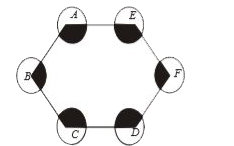As shown in the figure, three circles which have the same radius r,have centres at (0,0);(1,1)and(2,1). If they have a common tangentline, as shown then, their radius 'r' is -
Step by step video & image solution for As shown in the figure, three circles which have the same radius r,have centres at (0,0);(1,1) and (2,1). If they have a common tangentline, as shown then, their radius 'r' is - by Maths experts to help you in doubts & scoring excellent marks in Class 11 exams.
Updated on:21/07/2023Similar Questions
As shown in the figure, three circles which have the same radius r,have centres at (0,0);(1,1)and(2,1). If they have a common tangentline, as shown then, their radius 'r' is -
View SolutionIf two circles of the same radius r and centres at (−1,2) and (3,6) respectively cut orthogonally, then the value of r is
View Solution
Knowledge Check
Find the sum of the areas of the shaded sectors given that ABCDEF is any hexagon and all the circles are of same radius r with different vertices of the hexagon as their centres as shown in the figure.
 Aπr2B2πr2C5πr2/4D3πr2/2
Aπr2B2πr2C5πr2/4D3πr2/2C1 is a circle with centre at the origin and radius equal to r and C2 is a circle with centre at (3r, 0) and radius t 2r. The number of common tangents that can be drawn to the two circles are
A1B2C3D4
As shown in the figure , the five circles are tangent to one another consecutively and to the lines L1andL2. If the radius of the largest circle is 18 and that of smallest is 8. If radius of middle circle is r, then find the value of r/2
View SolutionTwo circles of radius r1andr2 touches externally at point A have a common tangent PQ. Then find the value of PQ2.
View SolutionThere are 4 circles on the figure. Two of them have radius 2 and the smallest one has radius 1. If the area of the dashed part is equal to the area of the filled part then find the radius of the largest circle. r
View SolutionFind the equation of the circles which touch 2x−3y+1=0 at (1,1) and having radius √13.
View SolutionIf |z|<1,then1+2z lies (A) on or inside circle having center at origin and radius 2 (B) outside the circle having center at origin and radius 2 (C) inside the circle having center at (1,0) and radius 2 (D) outside the circle having center at (1,0) and radius 2.
View SolutionIf |z|<1,then1+2z lies (A) on or inside circle having center at origin and radius 2 (B) outside the circle having center at origin and radius 2 (C) inside the circle having center at (1,0) and radius 2 (D) outside the circle having center at (1,0) and radius 2.
View Solution
